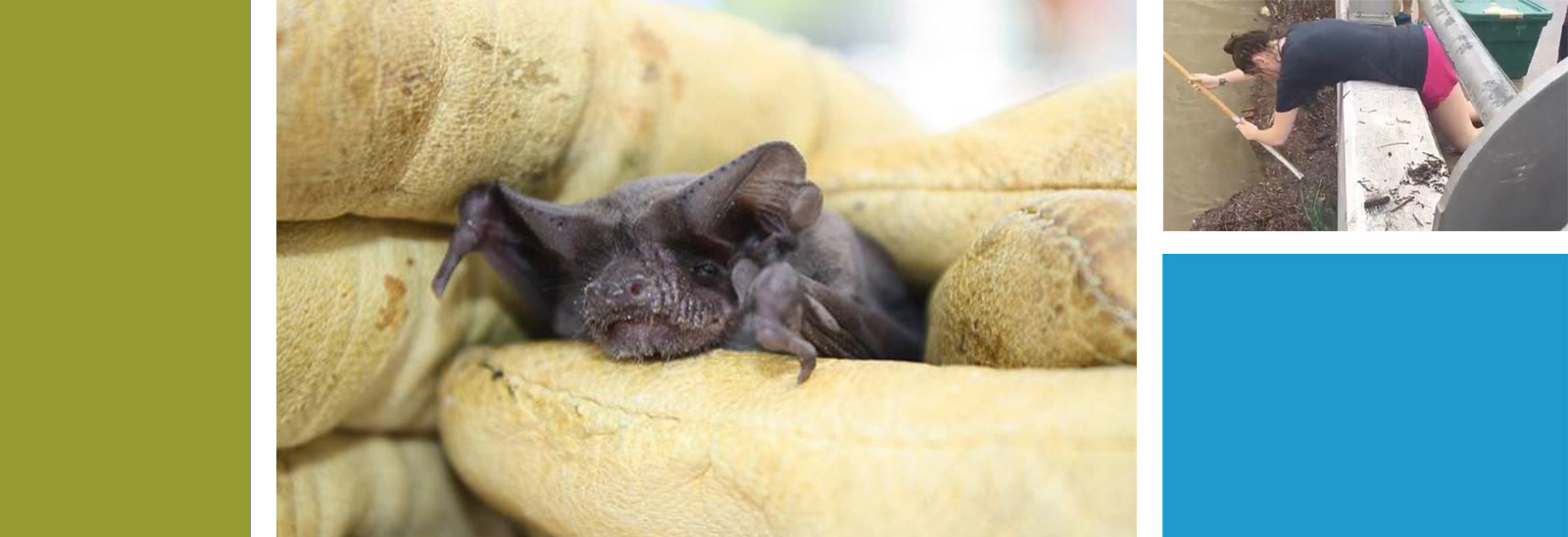September 5, 2017
Houston’s Bat Rescue Reminds Us of the Importance of This Creature

On the morning of August 29, dozens of volunteers braved unprecedented flooding in Houston, Texas to save a large colony of bats trapped underneath Waugh Bridge by a swelled Buffalo Bayou. Some bats escaped, finding refuge in nearby structures. Unfortunately, many attempting to leave the roost were unable to catch flight and merely fell into the water, drowning.
“Bats typically require at least a few feet to drop into flight, more if possible,” said Marieka Schrader, a Senior Associate Biologist and Environmental Planner with GPA Consulting. “In Houston, the waters rose to such a height that there was little to no free space between the bridge and the water, which likely prevented many bats from escaping, or made flight very difficult, resulting in bats falling into the water.”
Tropical Storm Harvey hit Houston so fast, it’s very likely that the bats missed their window of opportunity to escape, Schrader added.
Harvey slammed Texas’ south-eastern coast on Friday, Aug. 25 as a Category 4 hurricane. Harvey was turned back east of San Antonio and downgraded to a tropical storm before it dumped more than 50 inches of rain on the city of Houston. The record-breaking rain caused the Buffalo Bayou to overflow and flood nearby areas, including the Waugh Bridge. An estimated 250,000 Mexican free-tail bats were caught off-guard. Many of them, according to reports, young. This makes sense as the Mexican free-tails are at the end of their pupping season.
“Although most of the pups are able to fly, there are many juvenile bats that have less experience, and may make more mistakes and be more vulnerable once they are exposed,” Schrader said. “The good news is that some bats were able to escape and find nearby roosts. They were likely able to leave the roost before the water was too high, or before winds were too high. Or, they just got lucky.”
Bats tend to avoid flight in heavy rain and wind, Schrader said. “As you can imagine, being as small as they are, flight during high wind events would be difficult, if not impossible.”
It was extraordinary to see dozens of volunteers turn out to rescue one of the most misunderstood creatures in the animal kingdom. There are many unfortunate myths surrounding bats, including a belief they are vampires, that make them fearful to many people. The fact that many bat species are nocturnal also play on the fears of humans. The truth is that bats are important to agriculture and human health.
“Bats are one of the top predators of night flying insects, and they play a huge role in keeping down the insect population worldwide,” Schrader said. “This results in not only fewer mosquitos in stagnant waters, but fewer crop-destroying insects, which provides economic benefits.”
A study published six years ago in Science magazine estimates that bats save American farmers between $3.7 billion and $54 billion annually.
A concern expressed by volunteers rescuing bats in Houston was saving them so they could in turn keep down the mosquito population, which will become a health concern in the flooded city.
Bats also help pollinate many species of plants and help with seed dispersal.
“They are considered keystone species in many ecosystems,” Schrader added. “They are also an altruistic species, having been known to try and save pups by carrying them to safety when disturbed, and to adopt orphaned pups.”
Major storms aren’t the only threat to bats. There are 1,300 species of bats and many of them are threatened; mainly because of habitat disturbance and destruction. Bats typically give birth to one pup each year, putting them at further risk for population decline.
“Human disturbance of habitat, including recreational use of mines, is also a threat,” Schrader explained. “Each time a bat is disturbed during roosting, and even more so during hibernation, they use precious energy, which put them at risk of starvation.”
Schrader further explained there are new threats, including wind turbines and a fungus known as white-nose syndrome, that put some species of bats in danger of extinction.
On a positive note, Schrader said the Houston colony will likely recover and continue to thrive. Volunteers happily discovered after the water began to recede that thousands of trapped bats survived. “Natural disasters can be devastating on animals, and I have so much appreciation for the rescue groups that are out there working to rescue as many animals as possible, including the good Samaritans that took it upon themselves to pull hundreds of bats out of the bayou in Houston.”
Marieka Schrader is a Senior Associate Biologist and Environmental Planner at GPA, and leads the firm’s biology group. She is experienced in conducting daytime bat habitat assessment, evening bat emergence surveys, and bat night roosting surveys, as well as analysis of bat calls for bat species identification using Sonobat classification software.
Top Left Photo: Mexican free-tailed bat, U.S. Fish and Wildlife Service; Top Right Photo, Volunteer rescuing bats from Waugh Bridge in Houston, CBS News